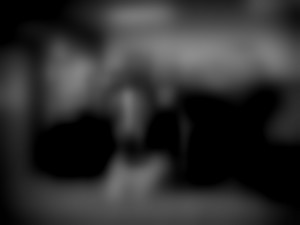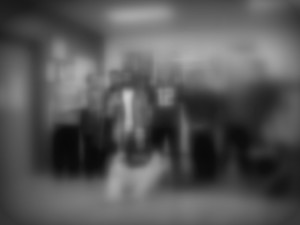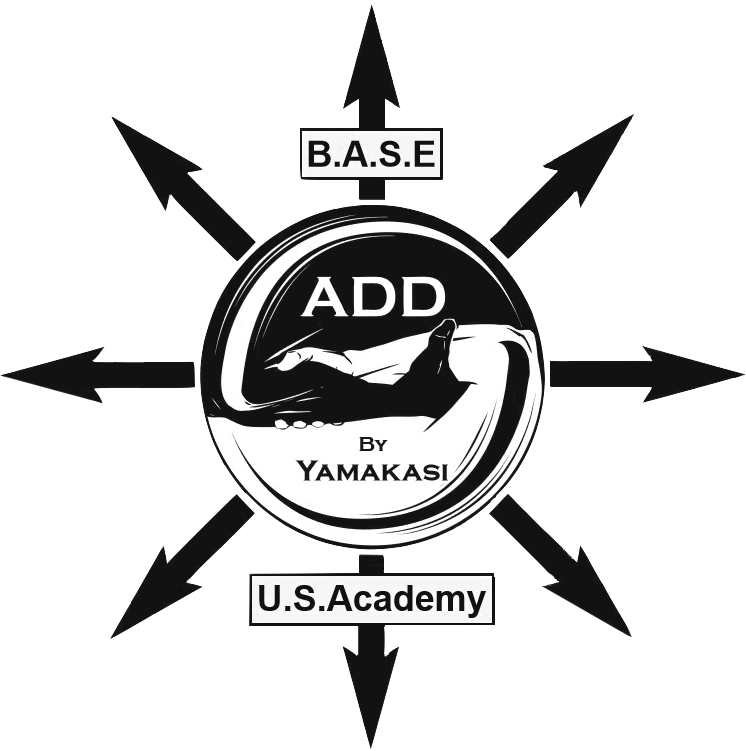lind Parkour: Working with the Perception of Limitation
Imagine practicing the Art du Deplacement / Parkour and this is how you see.

Everyone has varying degrees of vision.

Some can see clearly and others can just barely make out shapes.
This is about opening your eyes to possibility.
A little background on the inspiration of VIPK:
My wife had just undergone brain surgery for an acoustic neuroma and was left with the challenges of facial paralysis, single-sided deafness, vestibular imbalance, and vision loss from a ripped cornea. All of these things have given us opportunities to learn and grow as a couple. The education this experience has provided has set us on a journey to explore so much more than what our previous perceptions had allowed us to see.
Recently, a few friends of ours thought it would be nice to invite us to a fundraising banquet. The name of the event was called “Dining in the Dark.” As soon as we walked up to the venue, we were greeted by some individuals who were visually impaired. All check-ins and registrations were conducted through BOSMA who provided the employment opportunity for all of the visually challenged individuals. I personally had not been involved with this world before, so it was a whole new experience to me. All the money and proceeds from the dinner would go to further develop opportunities for employment and assistance for people who have sight challenges and need a means of providing for themselves as well as continuing to be productive elements in the community. Once we were seated at our dinner table, we were able to get quickly acquainted with the people with whom we would be sharing the evening. We were introduced to the man who would be our connection into this new experience: Nick Leon. This BOSMA Ambassador would later become a key element in opening doors that allowed Tammy and me to develop a Parkour program for the visually impaired.
At dinner we were asked to wear blindfolds as we began to eat our first course. Immediately we were intrigued by the new challenge and started creating new ways to navigate. Tactile sensations became very important and the simple tasks of figuring out what was on our plates and finding the locations of drinks, utensils and condiments became challenging. As we continued eating I started wondering how I would manage through some basic vault skills at B.A.S.E. Fitness Parkour without the use of my sight. We have done blindfold work before, but in short sessions. As the night went on, the desire to remove the blindfold faded and I could focus my attention on the sounds and sensations around me. I didn’t suddenly grow super hearing, but lack of sight made the sounds around me seem more focused. Without visual stimuli, my mind came alive with images.
And then, too soon, dinner was over. We were allowed to remove our masks and return to normal throughout the rest of the evening. I was a bit disappointed and also felt an overwhelming respect for those who still remained around us that did not have privilege of regaining sight once dinner was finished. It was hard enough to navigate around my own dinner plate while seated; I wondered how in the world could visually impaired people manage a crowded room? I was amazed at the smooth transitions and subtle touches my new friends were using that fed them the information they needed to react and respond. I began to see that everyone at BOSMA—the program coordinators and the visually impaired—were actually very approachable and not as distant as I had thought even only a few hours previously. I started to see young vibrant couples working together as well as eager individuals who were very outgoing and wanting to engage in conversation and action. I thought to myself, If I went blind would I stop being active? I began to realize that I’m no different than most of the people around me, and the drive to be active would not suddenly stop because I couldn’t see.
The next questions were, what would I do to continue to be active and what are the resources for an active individual who is visually impaired? After weeks of research, dialogue, and a tour at the BOSMA facility, I only came up with one real current outlet: Beep Ball.* This amazing sport allows for a bit of physical activity and sportsmanship and gives players an opportunity to sprint in one of two directions to tackle a pylon to score points. As I researched this game, I kept thinking, Man there are some freakin’ crazy Beep Ballers out there! I knew then that the camaraderie and support of the Parkour community could provide another outlet for the visually impaired community to dangle their feet over the edge and feel that sense of adrenaline of pure movement that so many of us love and live for. So I began running test classes made up of half visually impaired students and half students without visual challenges. We worked on direction and communication and started to bridge the gap between seeing Parkour and hearing Parkour, from regularly navigating jumps 10 feet in the air to not having any comprehension of height or space and therefore having a completely different feeling inside. It’s hard to imagine what the definition of “high” is if you don’t have the perception for seeing it. The classes helped us grow in ways we could not have known without being allowed access to the BOSMA community. So, long story still long but condensed a little J: Nick Leon, Tammy, and myself launched the first Visually Impaired Parkour / Art du Deplacement Program in 2015 with a handful of amazing people from BOSMA.
Introducing the BOSMA and B.A.S.E. Fitness Parkour VIPK athletes:
Adam Rodenbeck
My name is Adam Rodenbeck, and I am thirty-two. My vision loss is caused by a genetic condition called Leber Congenital Amaurosis. This condition primarily affects the retina and generally is diagnosed at an early age. I attended the Indiana School for the Blind, which is where I had my first exposure to athletics. Although I have always had trouble seeing, I have never allowed it to stop me from doing anything I put my mind toward.
While attending the Indiana School for the Blind I developed a healthy love of sports. I began wrestling at 5 and turned this into my sport of choice. By 2nd grade I also began swimming and running track. While these sports were fun, they were never really my passion. They served to keep me in shape during the off season of wrestling.
After graduation I found it much more difficult to play on sports teams. I attended college, but never had an interest in competing at that level. In 2004 a friend invited me to come try Beep Baseball. The sport immediately resonated with me, and I became an addict. Finally I found something I could play as an adult. I have now been to 11 national tournaments, and last year our team finished 2nd.
Beep Baseball has replaced wrestling for me and likewise has encouraged me to find other sports to keep up my conditioning during the off season. In 2011 I began distance running. I have competed in 4 half marathons as well as a full marathon. Running is a great stress relief for me, but it does not hold the same interest as playing Beep Ball.
Recently I was asked to participate in a pilot program to give people who are blind exposure to Parkour. As I have never let my vision stop me from doing anything and I love athletics, I decided to give it a try. I had heard of Parkour from a co-worker, and understood it to involve a lot of jumping from place to place. I figured there would be a lot of training before we would get to that level, so why not give it a try? We did learn many of the very basics of the sport, and began trying our hand at a few of the Parkour style moves.
From day one I loved it. It was difficult and showed me that I had taken a long winter off from sports. I loved the discipline required. While I have done a lot on my own, I have always liked participating with a team and having a real reason to get sweaty. Parkour did that for me, and taught me some valuable skills along the way. Parkour / Art du Deplacement is definitely something I would love to continue.
Imran Ahmed.
My name is Imran Ahmed and I am originally from Pakistan. I have been blind all my life due to a rare eye condition called Leber Congenital Amaurosis or LCA for short. I have always been actively involved in physical activities in one form or another. I used to play Cricket when I was in Pakistan. After coming to the US and moving to Indianapolis for work, I was introduced to an exciting sport by the name of Beep Baseball. I believe Parkour / Art du Deplacement will most definitely help me be stronger and stay fit to continue playing Beep Ball for many years to come!
Chris Dunlavy
My name is Chris Dunlavy and I was born June 12, 1971. I grew up with perfect vision. After graduating from Purdue University and then attending DePaul University Law School, I returned to Indiana, where I worked in the legal field. I have always been very active in sports and exercise. I even had the great fortune of running in the Chicago Marathon, the Marine Corps Marathon, and the New York City Marathon. However, beginning around the age of 31, I began to lose my vision. It has gotten to the point where I am legally blind, am unable to drive, and have very limited central vision.
Parkour / Art du Deplacement was an awesome experience for me. It gave me an opportunity to get back to using my other senses in combination with physical activity. Parkour provided me with the opportunity to work out while also preparing for adverse dangerous situations. The people at B.A.S.E. Parkour were so incredibly helpful, compassionate, and respectful.
We also had the pleasure of working with Sherry Williams and James Michaels.
Dear Ayren,
Thank you so much for the experience with Parkour / Art du Deplacement. As a man coping with vision loss, I was not sure what to expect as it pertains to navigating through the obstacles in your gym. With your instruction and encouragement I gained confidence throughout each station I encountered. It is a great work out as well as a confidence booster. I appreciated your willingness to give our clients and staff the opportunity to participate. I got nothing but great feedback from my Team and love that you are willing to think outside of the box to make Parkour / Art du Deplacement accessible to individuals who are blind or visually impaired. Best of luck in all you do and I hope we can build on this partnership in the future.
Sincerely,
James Michaels, LCSW
VP of Program Services
We plan on continuing to develop VIPK and learn more about how Parkour / Art du Deplacement can improve self esteem and confidence for everyone. The goal is to allow as many individuals who want to experience the art of movement to be able to explore safely and with quality instruction, and still keep it fun and exciting.
